This article was medically reviewed by Mark Ziats, MD, PhD. Dr. Mark Ziats is an Internal Medicine Physician, Scientist, Entrepreneur, and the Medical Director of xBiotech. With over five years of experience, he specializes in biotechnology, genomics, and medical devices. He earned a Doctor of Medicine degree from Baylor College of Medicine, a Ph.D. in Genetics from the University of Cambridge, and a BS in Biochemistry and Chemistry from Clemson University. He also completed the INNoVATE Program in Biotechnology Entrepreneurship at The Johns Hopkins University - Carey Business School. Dr. Ziats is board certified by the American Board of Internal Medicine.
There are 24 references cited in this article, which can be found at the bottom of the page.
This article has been viewed 211,706 times.
Experts agree that clogged arteries (atherosclerosis) decrease blood flow to your heart, which may cause chest pain and shortness of breath. However, the fatty deposits (plaque) that clog your arteries typically build up slowly over time, so you may not notice any symptoms until you already have a blockage.[1] You're likely really worried if you think your have clogged arteries, but you may be able to reduce plaque build-up with treatment. Studies show that making healthy lifestyle changes like eating a healthy diet, exercising, and not smoking may help.[2]
Steps
Identifying Common Symptoms of Clogged Arteries
-
1Look for symptoms of a heart attack. Specific symptoms can signal the beginning of a heart attack, during which oxygen-rich blood does not feed the heart muscle. If the heart does not get enough oxygen-rich blood, part of it can die. The amount of damage to the heart muscle can be reduced when you are treated with medications at a hospital within one hour of experiencing the symptoms. The symptoms include:[3]
- Chest pain or pressure
- Chest heaviness or tightness
- Sweating or "cold" sweats
- Feeling of fullness or indigestion
- Nausea and/or vomiting
- Lightheadedness
- Dizziness
- Extreme weakness
- Anxiety
- Rapid pulse or irregular heart rhythm
- Shortness of breath
- Pain radiating down the arm
- Pain described mostly commonly as squeezing or tightness of the chest, but not sharp pain
- Note that in women, elderly, and those with diabetes, heart attacks often don't have many of the common symptoms and can even present as other symptoms altogether. Fatigue is common.
-
2Identify symptoms of a blocked artery in the kidney. These can be different than the symptoms of a blocked artery elsewhere. Suspect a blocked artery in the kidney if you experience: high blood pressure that is difficult to control, fatigue, nausea, loss of appetite, itching skin, or difficulty with concentration.[4]
- If the artery is completely blocked, you may experience fever, nausea, vomiting, and steady aching pain in the lower back or abdomen.
- If the blockage is from small blockages that lodge in the renal artery, you may also have similar blockages in other areas of your body, such as in your fingers, legs, brain or intestines.
Advertisement -
3See your doctor if you experience any of these symptoms. While you may not be totally sure that you have a blocked artery, it's better to be safe than sorry. Contact your doctor and describe your symptoms her. Your doctor will either tell you to come into her office or to go to your closest emergency room.
-
4Remain still and do no activity if medical care is not available right away. Rest quietly until medical care arrives. By remaining very still you will reduce the oxygen needs and workload of the heart muscle.
- If you think you are having a heart attack, chew 325 mg of full-strength aspirin once you have contacted emergency services. If you only have baby aspirin, take four 81 mg pills. Chewing before swallowing will help the aspirin work faster.
Testing for Clogged Arteries
-
1Expect cardiac (heart) imaging and blood tests to find clogged arteries. Your physician will likely order blood tests to evaluate for the presence of certain sugars, cholesterol, calcium, fats and proteins in the blood that can raise the risk of atherosclerosis or clogged arteries.[5]
- The doctor may also order electrical studies of the heart using electrocardiogram to record electrical signals indicating if you have had a heart attack in the past or having one presently.
- Your doctor may also request imaging studies including echocardiogram, Computed Tomography (CT), and Magnetic Resonance Imaging (MRI) to evaluate how the heart is working, see blocked passages in the heart, and visualize any calcium deposits which may be contributing to narrowing or clogging of the heart arteries.[6]
- A stress test may also be conducted. This will allow the doctor to measure blood flow to the heart muscle under stress conditions.[7]
-
2Expect kidney function testing to determine of your renal arteries are blocked. Your physician may order a serum creatinine, glomerular filtration rate, and blood urea nitrogen test to evaluate your kidney function. These are all different tests on your urine. An ultrasound and CT scan may also be used to visualize blocked arteries or calcium deposits.[8]
-
3Get evaluated for Peripheral Artery Disease. Peripheral Artery Disease is a circulatory disease, in which your arteries are narrowed. This narrowing of the arteries reduces circulation to the limbs.[9] One of the simplest tests is to have your physician evaluate the two different pulses in your feet during a routine physical examination. You have a higher risk of having this disease if you are:[10]
- Under 50 years of age, have diabetes and at least one of the following: smoking, high blood pressure, and high cholesterol levels.
- Over 50 years of age and have diabetes
- Fifty years or older and have been a smoker
- Are at 70 years or older
- Have one or more of these symptoms: foot or toe pain at rest that disturbs sleep, a wound on the skin of the foot or leg that is slow to heal (longer than 8 weeks), and fatigue, heaviness, or tiredness of the leg, calf, or buttock muscles which happens with activity and goes away with rest.
Preventing Clogged Arteries
-
1Understand the causes behind clogged arteries. While many people believe the fatty substance that blocks arteries is caused by an excess of cholesterol, this explanation is much simpler than the complexities of the different sizes of cholesterol molecules. Cholesterol is required by the body to make vitamins, hormones and other chemical transmitters. Researchers have discovered that while certain cholesterol molecules are dangerous to your heart and developing clogged arteries, it is sugar and carbohydrates which set up an inflammatory response in the body that is a significant precursor to atherosclerosis.[11]
- While you might be steering clear of saturated fats to reduce your cholesterol level and risk of atherosclerosis and clogged arteries, you will have been making a significant mistake. Eating healthy saturated fats has not been scientifically linked with heart disease and clogged arteries. [12] [13]
- However, diets high in fructose, sugar-filled low-fat food options, and whole grain wheat have been linked to dyslipidemia creating clogged arteries. Fructose can be found in beverages, fruits, jelly, jams and other pre-sweetened food.[14] [15] [16] [17] [18]
-
2Eat a healthy diet rich in healthy saturated fats and low in sugar, fructose, and carbohydrates. Carbohydrates are metabolized into sugars in the body and will also increase the inflammatory response. Large amounts of sugar, fructose, and carbohydrates will increase your risk of developing diabetes. Diabetes increases your risk of clogged arteries.
- This includes only drinking a moderate amount of alcohol.
-
3Stop smoking. The exact toxic components in tobacco which trigger atherosclerosis and clogged arteries is not known, but researchers do know that smoking is a primary risk for inflammation, thrombosis and the oxidation of low-density lipoproteins, all of which contribute to clogged arteries.[19]
-
4Keep your weight within normal weight range. Increased weight increases your risk of diabetes. Diabetes, in turn, increases your risk of clogged arteries.
-
5Get regular exercise for 30 minutes every day. A lack of physical exercise is one of the factors that predict 90% of the risk of heart attacks in men and 94% of the risk in women.[20] Heart disease and heart attacks are just two of the results of clogged arteries.
-
6Try to reduce the stress. Another contributing factor may be your levels of stress. Just remember to relax and take breaks that will help you to unwind. While taking your blood pressure won't tell you how bad you cholesterol is, it can most definitely be an indicator in whether or not you should be concerned.
-
7Talk to your doctor about medication. Your doctor may prescribe a drug called a statin to reduce the buildup of plaque in your arteries.[21] They cause your body to stop producing cholesterol in the hope that it will instead absorb the existing cholesterol that is built up in you arteries.[22]
- Statins are not for everyone, but if you have diabetes, already have heart disease, have high levels of cholesterol (190 mg/dL or higher LDL cholesterol), or a high 10-year risk of heart attack, your doctor may recommend you try it.[23]
- Statins include atorvastatin (Lipitor), fluvastatin (Lescol), lovastatin (Altoprev), pitavastatin (Livalo), pravastatin (Pravachol), rosuvastatin (Crestor) and simvastatin (Zocor).[24]
Warnings
- Although clogged arteries often cause the most damage in the area in which they build-up, these deposits on the artery walls can break loose and totally block the flow of blood in the brain or heart causing a heart attack or stroke.[25]⧼thumbs_response⧽
- Blocked arteries in the heart can result in angina. This is chronic chest pain that gets better with rest. This condition must be addressed and treated since it can result in a heart attack.[26]⧼thumbs_response⧽
References
- ↑ https://www.hopkinsmedicine.org/health/conditions-and-diseases/atherosclerosis
- ↑ https://my.clevelandclinic.org/health/diseases/16898-coronary-artery-disease/management-and-treatment
- ↑ http://my.clevelandclinic.org/services/heart/disorders/coronary-artery-disease/cadsymptoms
- ↑ https://www.merckmanuals.com/home/kidney-and-urinary-tract-disorders/blood-vessel-disorders-of-the-kidneys/blockage-of-the-renal-arteries
- ↑ http://www.nlm.nih.gov/medlineplus/magazine/issues/fall10/articles/fall10pg26-27.html
- ↑ http://www.mayoclinic.org/diseases-conditions/coronary-artery-disease/basics/tests-diagnosis/con-20032038
- ↑ https://www.health.harvard.edu/heart-disease-overview/cardiac-exercise-stress-testing-what-it-can-and-cannot-tell-you
- ↑ https://www.kidney.org/atoz/content/kidneytests
- ↑ https://www.cdc.gov/heartdisease/PAD.htm
- ↑ http://www.nlm.nih.gov/medlineplus/magazine/issues/fall10/articles/fall10pg25.html
- ↑ http://archinte.jamanetwork.com/article.aspx?articleid=1819573
- ↑ http://annals.org/article.aspx?articleid=1846638
- ↑ http://ajcn.nutrition.org/content/early/2010/01/13/ajcn.2009.27725.abstract
- ↑ http://www.ncbi.nlm.nih.gov/pmc/articles/PMC2673878/
- ↑ http://www.ncbi.nlm.nih.gov/pubmed/23594708
- ↑ http://www.ncbi.nlm.nih.gov/pubmed/23299714
- ↑ http://online.liebertpub.com/doi/abs/10.1089/jmf.2009.0092
- ↑ http://ajcn.nutrition.org/content/76/2/351.full
- ↑ http://content.onlinejacc.org/article.aspx?articleid=1135615
- ↑ http://www.ncbi.nlm.nih.gov/pmc/articles/PMC2716237/
- ↑ https://www.hopkinsmedicine.org/health/conditions-and-diseases/atherosclerosis
- ↑ http://www.mayoclinic.org/statins/art-20045772
- ↑ http://www.mayoclinic.org/statins/art-20045772
- ↑ http://www.mayoclinic.org/statins/art-20045772
- ↑ http://www.heart.org/HEARTORG/Conditions/Cholesterol/WhyCholesterolMatters/Atherosclerosis_UCM_305564_Article.jsp
- ↑ http://my.clevelandclinic.org/services/heart/disorders/coronary-artery-disease/understandingcad
About This Article
One common, serious symptom of clogged arteries is having a heart attack. If you experience chest pain, shortness of breath, rapid pulse, irregular heart rhythm, lightheadedness, and dizziness, call for medical help immediately, and rest quietly until help arrives to reduce the pressure on your heart. You should also chew and swallow 325 milligrams of aspirin once you have contacted emergency services, as this slows blood clotting. You can also have blocked arteries in your kidney, in which case you may experience fever, nausea, vomiting, and lower back or abdominal pain. For more tips from our Medical co-author, including how to prevent clogged arteries, read on!
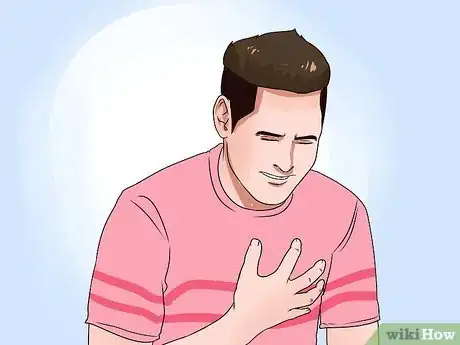
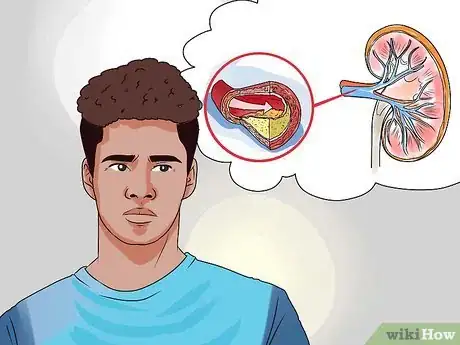
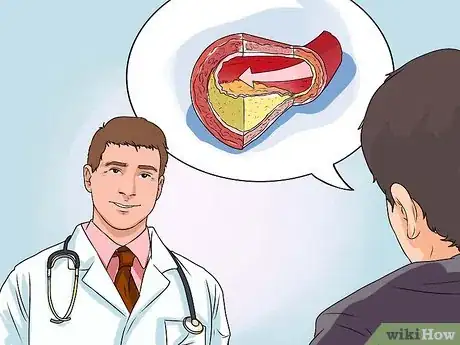

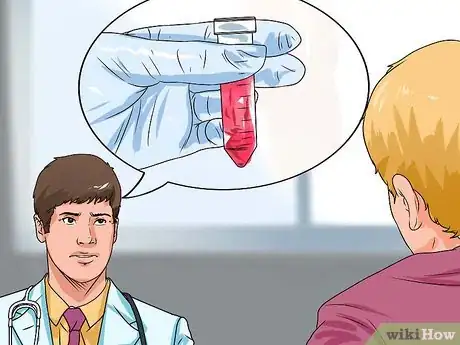
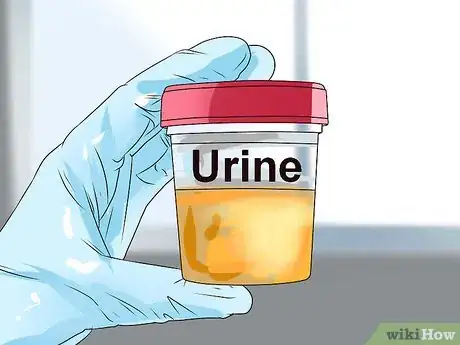

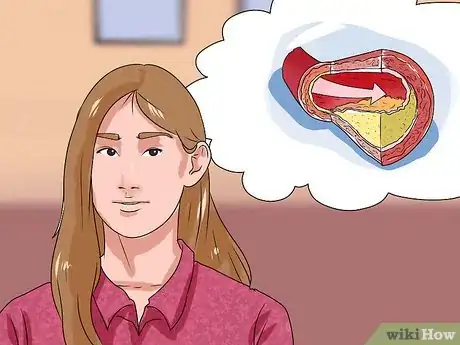

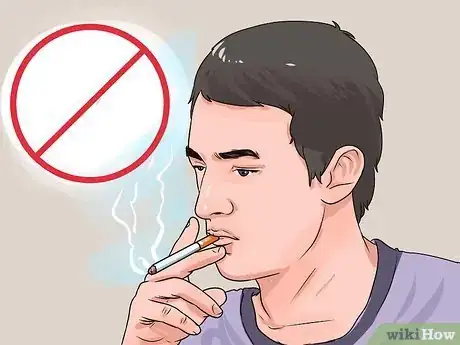

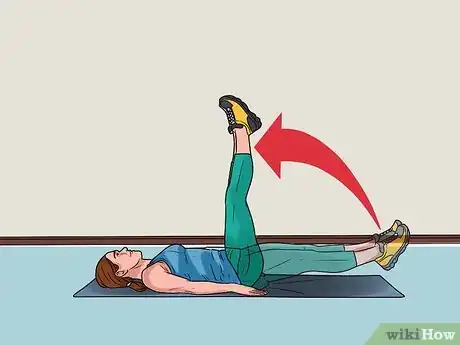

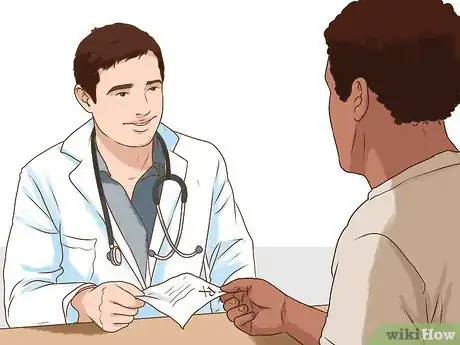
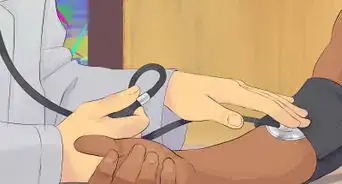
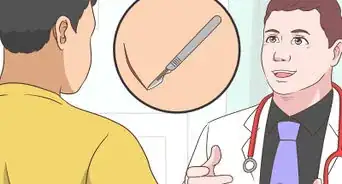












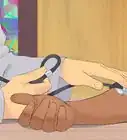
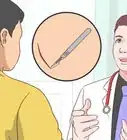
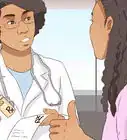





































Medical Disclaimer
The content of this article is not intended to be a substitute for professional medical advice, examination, diagnosis, or treatment. You should always contact your doctor or other qualified healthcare professional before starting, changing, or stopping any kind of health treatment.
Read More...